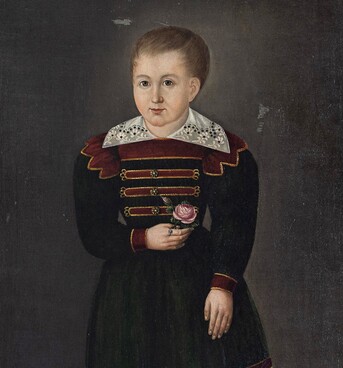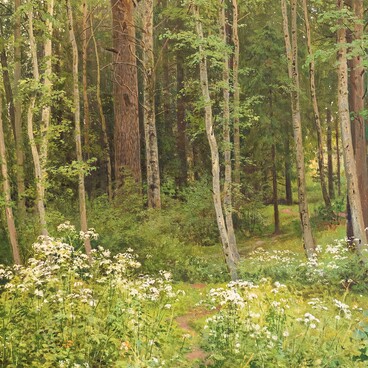The painting ‘Volsk in the 1840s’, created by artist Pleshcheyev, depicts a panorama of Volsk from the side of the chalk mountains — the name given to rocks or peaks that consist of chalk. In the 19th century, cement plants were built in such places in Russia.
The canvas shows the town’s clear rectangular building, as well as its cathedrals, and other landmarks. There are gardens all over the town, and blue waters of the Volga River are seen in the background.
Some stone houses built in Volsk in the first half of the 19th century have survived to this day and are recognized as architectural monuments of city significance.
The first official records of the village of Malykovka were made in 1699. The main activity of residents was fishing, and the yield was sent to monasteries. In 1710, Emperor Peter I granted Malykovka along with the volost to Alexander Menshikov, and in 1728, the village passed into the state treasury.
When the Saratov viceroyalty was created in 1780, by the decree of Empress Catherine II the village was transformed into the district town of Volgsk. Later the name was changed to Volsk which was easier to pronounce. The local merchants, who also contributed to the development of trade, played the main role in the construction of the city.
The fire of 1792 destroyed almost all wooden buildings of the town center. The following year, Volsk was the first in the province to adopt a “regular design plan”. According to it, Volsk was to be constructed as a traditional town. Therefore, in 1797, there were eight new streets in the town built according to the plan.
In 1806–1813, large-scale construction took place in Volsk: over 100 stone buildings were built, which was more than in Saratov. The buildings were erected according to both exemplary and special projects, although it was difficult to obtain permission for such a development at that time. However, wealthy Volsk residents preferred the second option.
At that time, the city was called “Kamenny khutor” (Small stone village) along with a more flattering name meaning “Volsk — a piece of St. Petersburg”. The town center was formed by buildings that resembled small palaces, while the outskirts were full of parks and gardens. Visitors were fascinated with the town’s cobblestone sidewalks and two- and three-story houses with mansards, courtyards and stone gates.
Historian Nikolay Kostomarov, who visited Volsk in the 1840s, wrote, ‘The town is situated on an uneven, semicircle hill terrain. The area is very picturesque <…> inspires those who are capable of appreciating the beauty of nature.’
The canvas shows the town’s clear rectangular building, as well as its cathedrals, and other landmarks. There are gardens all over the town, and blue waters of the Volga River are seen in the background.
Some stone houses built in Volsk in the first half of the 19th century have survived to this day and are recognized as architectural monuments of city significance.
The first official records of the village of Malykovka were made in 1699. The main activity of residents was fishing, and the yield was sent to monasteries. In 1710, Emperor Peter I granted Malykovka along with the volost to Alexander Menshikov, and in 1728, the village passed into the state treasury.
When the Saratov viceroyalty was created in 1780, by the decree of Empress Catherine II the village was transformed into the district town of Volgsk. Later the name was changed to Volsk which was easier to pronounce. The local merchants, who also contributed to the development of trade, played the main role in the construction of the city.
The fire of 1792 destroyed almost all wooden buildings of the town center. The following year, Volsk was the first in the province to adopt a “regular design plan”. According to it, Volsk was to be constructed as a traditional town. Therefore, in 1797, there were eight new streets in the town built according to the plan.
In 1806–1813, large-scale construction took place in Volsk: over 100 stone buildings were built, which was more than in Saratov. The buildings were erected according to both exemplary and special projects, although it was difficult to obtain permission for such a development at that time. However, wealthy Volsk residents preferred the second option.
At that time, the city was called “Kamenny khutor” (Small stone village) along with a more flattering name meaning “Volsk — a piece of St. Petersburg”. The town center was formed by buildings that resembled small palaces, while the outskirts were full of parks and gardens. Visitors were fascinated with the town’s cobblestone sidewalks and two- and three-story houses with mansards, courtyards and stone gates.
Historian Nikolay Kostomarov, who visited Volsk in the 1840s, wrote, ‘The town is situated on an uneven, semicircle hill terrain. The area is very picturesque <…> inspires those who are capable of appreciating the beauty of nature.’



